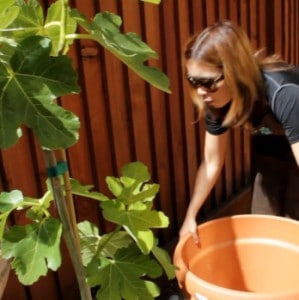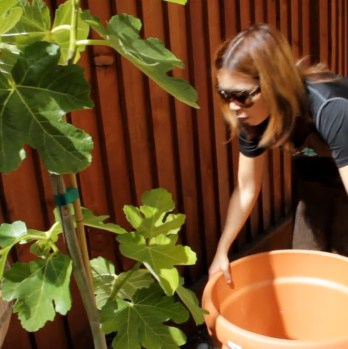 Fig trees are not only visually beautiful—sporting wide, lush green leaves—but they also produce tasty fruit. It’s a welcome enhancement to any garden or yard, so I thought they’d make a perfect addition to our courtyard on either side of a fountain. Did you know that the edible fig is one of the first plants cultivated by humans? Best of all, they’re easy to plant, readily available (if you live in a Mediterranean climate such as the San Francisco Bay Area) and can can be eaten fresh or dried, and used in jam-making. As a bonus, figs are one of the highest sources available for fiber and calcium.
Fig trees are not only visually beautiful—sporting wide, lush green leaves—but they also produce tasty fruit. It’s a welcome enhancement to any garden or yard, so I thought they’d make a perfect addition to our courtyard on either side of a fountain. Did you know that the edible fig is one of the first plants cultivated by humans? Best of all, they’re easy to plant, readily available (if you live in a Mediterranean climate such as the San Francisco Bay Area) and can can be eaten fresh or dried, and used in jam-making. As a bonus, figs are one of the highest sources available for fiber and calcium.
So here it is, a gardening video of astounding proportions: how to plant a fig tree. In fact, two of them. One on the left, and one on the right. I bought a few large terracotta pots, plus some soil and compost at the local nursery and off I went. Growing fig trees or any plant for that matter in large containers is a fantastic way to soften up any space while still keeping plants controlled and confined.
There are eight known cultivars of the fig tree. The one seen here is Brown Turkey. Fig trees have a long history. These trees were first planted 9400–9200 BC, just a few years before American Idol and Glee. While in Baja California Sur, I saw some amazing fig trees that had exposed intertwining roots which formed during droughts when the fig tree needed to search for sources of water.
There are two crop potentials each year, and since these are planted in spring, the first batch is likely later in the fall, if all goes well. When I was planting these fig trees, I couldn’t help but imagine all the great salads and dishes that use figs. Is it too optimistic to think I will get any fruit in their first season?
Covered here: potting, using stones for proper drainage, soil, amender, watering, micro-irrigation and even up-lighting which can add a nice effect at night. I look forward to hearing about your results, and any suggestions you may have in working with figs.


